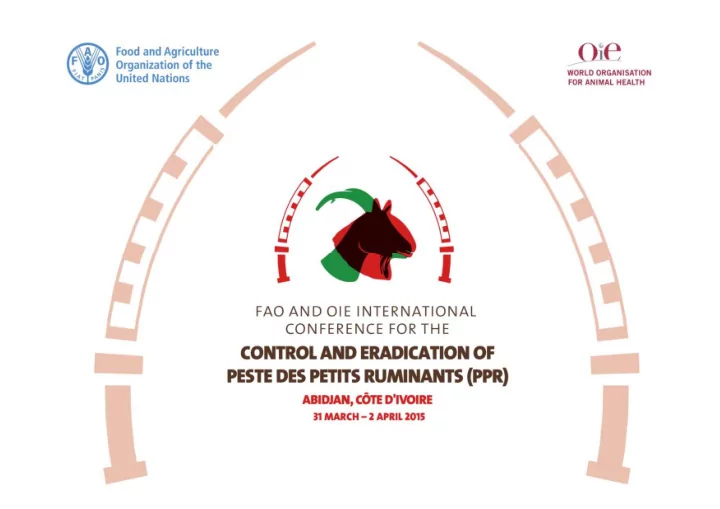

Drs Rachid Bouguedour & Alessandro Ripani OIE Sub-Regional Representation for North Africa Review of PPR in the Northern Africa Region
Peste des Petits Ruminants Increasingly important viral disease In developing countries: lowers production efficiency, food insecurity, poverty at the household level, particularly on livelihood poor farmers, trade impact, export restrictions One billion small ruminants are at risk annually Small ruminants population in North Africa approximately 70 million heads (> 12% of Africa) 3
Peste des Petits Ruminants Estimated number of sheep and goats by country and major pathways of the traditional movements of small ruminants in the Maghreb region 4
Peste des Petits Ruminants Cumulative outbreaks of PPR in the Maghreb region by country from 2008 to 2013 1 Present since 80s 5
Peste des Petits Ruminants (Morocco) Morocco experienced the first incursion of the disease in the “little Maghreb” in 2008 and the disease spread rapidly in the country mainly through animal trade A large number of outbreaks were reported from July 2008 to November 2008 6
Peste des Petits Ruminants (Morocco) Date of 1° outbreak: 18 July 2008 - Location: Moulay Yacoub; Benslimane N. total outbreaks: 257 N. of departments: 36 N. of animals: 5,633 Morbidity: 11.93% Mortality: 5.53 Last outbreak: 5 November 2008 7
Peste des Petits Ruminants (Morocco) Morocco applied a mass vaccination campaign started late in the summer 2008 and was concluded in December 2008 (about 20 million of small ruminants) Extensive vaccination campaigns were also repeated in 2010 and 2011 Sero-surveillance activities were conducted to monitor the post vaccination efficacy and potential virus circulation 8
Peste des Petits Ruminants (Algeria) Algeria reported the first outbreaks in the country in 2011 7 outbreaks in the South-western part of Algeria In 2012 and 2013 the disease reoccurred in Algeria respectively with a total of 3 and 4 outbreaks occurred in the same wilaya (Ghardaïa, in the Center of Algeria) Amongst the control measures put in place to stop the outbreaks there were: an intensified surveillance for small ruminants in both livestock markets and farms vaccination in the wilaya of Ghardaïa and the neighbouring wilayas 9
Peste des Petits Ruminants (Tunisia) Tunisia reported PPR for the first time in 2009 but major outbreaks were experienced in 2012 and 2013 Although the disease affected several Governorates, the majority of the outbreaks occurred in the governorate of Sidi Bouzid (center of the country) where it is known to be high density of traders. Tunisia has not applied vaccination against PPR up to date Distribution of the outbreaks in 2012 in Tunisia 10
Peste des Petits Ruminants (Mauritania) In Mauritania the disease is considered endemic in the country since 80s. Major diseases prevalence in the South territory where there is high density of small ruminants and because there would be intense exchange of animals with countries located in the South where the disease is also present Distribution and number of the PPR outbreaks in Mauritania in 2013 The vaccination in Mauritania is applied solely around the outbreaks Source : Ministry of Agriculture of Mauritania 11
Peste des Petits Ruminants (Libya) Libya: positive serological results were obtained over the past recent survey indicating the presence of the disease in the country Although it would be reported the presence of the disease through the OIE six monthly report - as of today - no official immediate notification for PPR was submitted to the OIE; 12
Peste des Petits Ruminants (Lineages) Laboratory investigations indicated that lineage IV of PPR was first identified in Morocco and later in Tunisia and Algeria (2009-2012) Another recent investigation highlighted the circulation of lineage II in Mauritania in 2012 underlining two different PPR viruses epidemiologic systems of virus circulation between the Northern Africa zone and Western North Africa Northern Africa : where all identified PPRVs belonged to lineage IV; and Western Africa : where all identified PPRVs belonged to lineages I and II 13
Peste des Petits Ruminants (Lineages) 14
Peste des Petits Ruminants - Conclusions (1) The incursion of PPR in the Maghreb region showed moderate clinical signs and low mortality rate Countries in the Maghreb region have in place a constant passive surveillance for reporting PPR along with intermittent/occasional active sero-surveillance investigations to evaluate the evolution of the disease or possible virus circulation The animal farming and livestock production in region are similar and the implementation of coordinated control measures and protocols for epidemiological surveillance and investigations are deemed appropriate 15
Peste des Petits Ruminants - Conclusions (2) In November 2013, countries in the Maghreb Region started working together and were the CVOs agreed to improve the sanitary status for PPR and to develop a regional control and eradication strategy in the Region In May 2014 an additional technical meeting were convened at the Sub regional office in Tunis between countries to define the timeline to prepare the dossier to apply for an OIE endorsed official control programme for PPR and to develop a regional control strategy During the second semester of 2015, another meeting will be organised to continue the process started in November 2013; 16
Peste des Petits Ruminants - Conclusions (3) The OIE Sub regional Representation for North Africa is coordinating and providing guidance - along with experts from OIE HQ - to these countries to move forward in a coordinated manner; The development of a regional approach for PPR should be in line with the principles and objectives of the Global Control and Eradication strategy developed by the OIE and FAO by considering the epidemiological situation in the Maghreb area; 17
Thank you
Recommend
More recommend